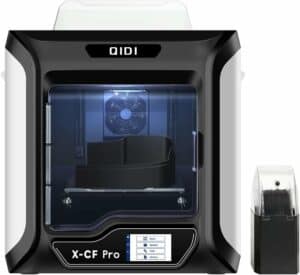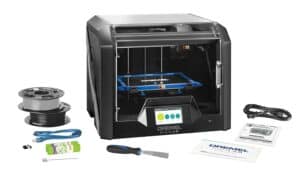Best 3D Printer Under $2000: High-end 3D Printers for the home

Table of Contents
In the multifaceted world of 3D printing, it can be difficult to find the right balance between affordability and performance. The best 3D printers under $2000 manage to strike that balance perfectly: whether you’re a 3D printing veteran or looking to get started on a budget, there are some fantastic options available.
A budget of around $2000 is going to guarantee quality printing results, impressive features, and reliability.
Products at a Glance
How We Picked the Best 3D Printer Under $2000
While choosing the best 3D printers under $2000 on the market, we prioritized the presence of a user-friendly interface, high printing quality, and reliable performance. We also tried to include printers that fit every taste and need, ranging from hobbyists to professionals.
Throughout the process, our main goal was to present a range of 3D printers that not only meet budget constraints but also cater to the unique demands of creators across skill levels and creative pursuits. This meant accounting for different filament choices, print speeds, and build volumes – all relative to the under $2000 price point.
Product Reviews
- Versatile filament options
- Automatic leveling
- Slow print speed
The Qidi Technology X-CF Pro is a game-changer in the world of 3D printing under $2000. From automatic leveling to large print volume, this printer truly has something for everybody.
The X-CF Pro features nylon and carbon fiber compatibility thanks to its high-temperature dual-gear extruder. These extruders can print standard filaments such PLA and ABS, along with exclusive QIDI nylon and carbon fiber filaments. To guarantee the printer’s accuracy and stability, it is equipped with a dual Z-axis structure and an industrial guide. What’s more – an ease-of-use feature we all greatly appreciate – the X-CF Pro comes pre-assembled to minimize the time between delivery and printing.
If we had to point out a flaw in this printer’s design, it would be the slow printing speed: at 60mm/s, it’s quite unimpressive compared to other top 3D printers. That said, for premium printing at a great price point, we highly recommend the QIDI X-CF Pro as a phenomenal 3D printer under $2000!
- Fast print speeds
- Affordable
- High-quality printing
- No filament run-out detection
- Bulky and heavy
To get as much under $2000 for your 3D printer budget, the MAX3 from QIDI is a high-speed 3D printer that keeps you well under-budget. Often available for less than $1000, the MAX3 comes packing a myriad of features that’ll elevate your printing experience without exceeding your price cap.
The MAX3 comes with an excellent printing speed of 600mm/s, which surpasses most competitors at the same price point. It’s made from an ultra-stable all-metal frame that keeps your prints anchored all the time with minimal maintenance. The build plates are easy to remove without damaging your model, and the direct-drive extruders reliably print using an array of filaments with ease.
You’ll want to keep an eye on your filament levels, however: with no filament run-out detectors, you can lose print progress easily if you aren’t careful. Another issue users may run into is the 3D printer itself: that stable all-metal frame makes the MAX3 a cumbersome module to move. But for budget-friendly premium 3D printing under $2000, you can’t beat the MAX3!
- Premium print quality
- Fast print speeds
- Automated filament adjustments
- Limited build volume
- Poor camera quality
If you want the absolute best value from your $2000 budget, then consider the Dremel DigiLab 3D45. A favorite of ours as an ABS 3D printer, the DigiLab offers a premium 3D print solution for those who value quality above all else.
One of the standout features of this 3D printer is its built-in RFID reader which detects whatever filament you load into it and optimizes the printing settings accordingly. This way, you guarantee intricate printing no matter what filament you choose. It also features a rigid glass bed that adheres to the models tightly till the printing ends and it cools down. You can observe your print progress via the HD camera that monitors the printing bay. Though the 150mm/s print speed is rather humble, the DigiLab promises high-quality prints every time.
However, there are still some nitpicks we can raise regarding this 3D printer. The enclosed design means that your build volume is limited, and whilst we appreciate the option to view our designs in progress, the camera is not large enough to provide enough detail. In spite of these flaws, we still highly recommend the DigiLab as a top-quality small-build 3D printer under $2000!
- Highly versatile print solution
- Auto-leveling bed
- Large print volume
- Large model
We sung the praises of the Snapmaker A350T in our buyer’s guide on auto-leveling 3D printers. A 3-in-1 manufacturing powerhouse, this 3D printer allows for the creation of intricate 3D objects with minimal hassle and is a phenomenal model! Not only is it a contender for best 3D printer under $2000, but one of the best consumer-grade 3D printers period!
Alongside 3D printing, the A350T is also capable of laser engraving and CNC carving all within its single design. The machine’s interface is exceptionally advanced, and allows for the simultaneous processing of multiple objects and the creation of personalized profiles. It also features a power loss recovery function, ensuring that you can continue your projects in case of power interruptions, as well as an automated filament run-out detection.
There is very little to dislike about the A350T: the model is quite large, but packs a lot of great features for that size! It may not be the best for beginners, but any 3D printing enthusiast will adore this model. And with a price well under $2000, this is one of the very best 3D printers no matter your needs!
Best 3D Printer Under $2000: Features and Considerations
When looking into the best 3D printers under $2000, and 3D printers as a whole, there are some other factors you should consider:
Build Volume
Just as 2D printers have a maximum print size, even at wide format, a 3D printer has a maximum volume. This determines the maximum 3D print that you can create with the printer. Though different models have different volumes, an open-frame 3D printer will generally have a larger maximum volume than an enclosed model.
Filament Support
3D printers are capable of printing using a wide variety of materials. Depending on your planned use, it is worth checking whether a 3D printer is capable of using that particular filament. We recently looked at food-safe 3D printers for cookie cutters, for example, where it was essential that the material used was non-toxic. You can always double-check with a manufacturer before your purchase, to be extra-safe.
Print Speed
If you have plans to create materials quickly and efficiently, then a high-speed 3D printer is essential. Most 3D printers list their speed in millimeters per second (mm/s), and will determine how much material is created. Most 3D printer slicers allow you to determine a target print speed below this number.
What is acceleration for 3D printers?
Acceleration determines how quickly a 3D printer extruder reaches a certain print speed, measured in square millimeters per second (mm/s²). It is a determining factor in print speed, and affects how quickly a printer can return to printing after changing nozzle direction.
Are 3D printers under $2000 worth it?
Yes: Whilst there are more expensive 3D printers for industrial use, the best 3D printers under $2000 are great consumer-grade models – with some even suitable for small-to-medium business needs!
Our Verdict
For the all-round best 3D printer under $2000, the QIDI X-CF Pro is our top choice! Though it’s a lot slower than its contemporaries, this 3D printer makes up for it with high-quality models in a breath of materials. QIDI’s unique materials are a high-quality godsend, and will make using this premium model an exciting and efficient masterclass!
If you want a 3D printer but need the decimal point moved, check out our buyer’s guide on the best 3D printers under $300!



